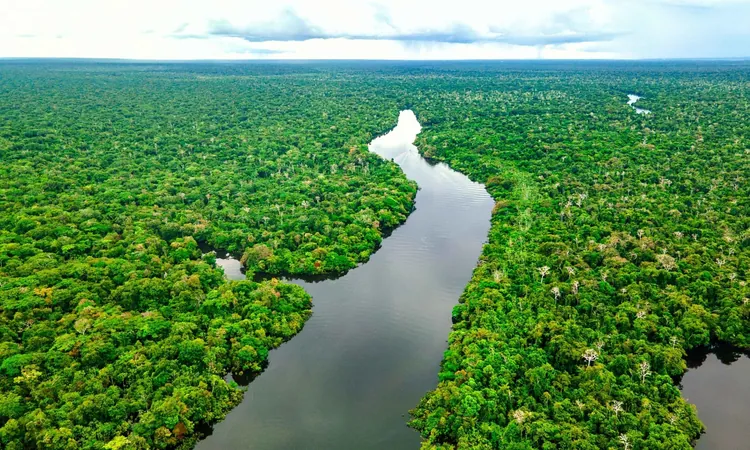
Unexpected Rainfall Boost for the Amazon as Ocean Currents Weaken
2025-06-14
Author: Jia
A Surprising Climate Connection
In a world grappling with climate change, the dynamics of our forests can flip in unexpected ways. Recent findings reveal that a weakening of the Atlantic Meridional Overturning Circulation (AMOC) could lead to increased rainfall during the driest months in the southern Amazon.
The Mystery Behind Ocean Changes
For decades, scientists have monitored ocean temperatures and current patterns, uncovering a stark connection between the cooling northern Atlantic waters and rainfall patterns across South America. Dr. Annika Högner, leading the research at the International Institute for Applied Systems Analysis (IIASA), spearheaded this fascinating investigation.
Diverging Trends in the Amazon
The AMOC is a crucial oceanic system; its weakening alters heat distribution towards northern regions, which in turn boosts moisture flow to parts of South America. Strikingly, the researchers discovered a 4.8% increase in dry season rainfall correlating with a weakened AMOC, providing a glimmer of relief in an otherwise troubling scenario.
Rainfall Amidst Declining Trends
However, not all news is good. Despite this localized increase in rainfall, the overall trend points to a dry Amazon, exacerbated by soaring temperatures and rampant deforestation caused by human activities. The dry season stands as the most critical time for the rainforest's survival, and while the AMOC brings some moisture, it's not enough to counteract the ongoing challenges.
Research Methodology and Observations
To draw these connections, researchers analyzed 40 years of data, focusing on how cooler northern waters impacted moisture flow patterns and the Caribbean low-level jet—an essential wind system directing airflow into the region.
A Complicated Climate Puzzle
Co-author Nico Wunderling from the Potsdam Institute for Climate Impact Research cautioned, "The Amazon is still drying. The moisture increase from the AMOC is pitted against the dire impacts of land degradation and warming temperatures." Even with this added rainfall, the dryness continues to encroach, thanks to elevated evaporation rates and diminishing forest cover.
Monitoring the Amazon from Space
Utilizing satellite-derived NDVI data, researchers evaluated the health and green cover of the southern Amazon, linking higher vegetation indices to years with enhanced dry season rainfall, suggesting that this additional moisture could be a crucial lifeline for the struggling ecosystem.
The Long-Term Forecast
While the study notes the weakened AMOC has mitigated about 17% of the rainfall loss since the 1980s, it cannot counteract the looming threat of global warming. The researchers stress the importance of reducing greenhouse gas emissions swiftly, as oceanic changes alone cannot reverse widespread climatic damage.
The Need for Vigilance and Protection
Continued monitoring of the Amazon and the AMOC is essential. Future rainfall patterns will be influenced by shifting land use and ocean conditions. The Amazon, a vital component of global biodiversity, must be protected to sustain its role in carbon sequestration and ecosystem health.
Vital Insights for the Amazon's Future
The dry season is particularly perilous for the Amazon, as any reduction in rainfall can lead to catastrophic consequences for tree health and biodiversity. The research underscores that even slight increases in precipitation during these critical months can have significant implications for forest stability.
As this important study unfolds in Environmental Research Letters, the call to action is clear: safeguarding the integrity of the Amazon is crucial for the future of our planet.



 Brasil (PT)
Brasil (PT)
 Canada (EN)
Canada (EN)
 Chile (ES)
Chile (ES)
 Česko (CS)
Česko (CS)
 대한민국 (KO)
대한민국 (KO)
 España (ES)
España (ES)
 France (FR)
France (FR)
 Hong Kong (EN)
Hong Kong (EN)
 Italia (IT)
Italia (IT)
 日本 (JA)
日本 (JA)
 Magyarország (HU)
Magyarország (HU)
 Norge (NO)
Norge (NO)
 Polska (PL)
Polska (PL)
 Schweiz (DE)
Schweiz (DE)
 Singapore (EN)
Singapore (EN)
 Sverige (SV)
Sverige (SV)
 Suomi (FI)
Suomi (FI)
 Türkiye (TR)
Türkiye (TR)
 الإمارات العربية المتحدة (AR)
الإمارات العربية المتحدة (AR)